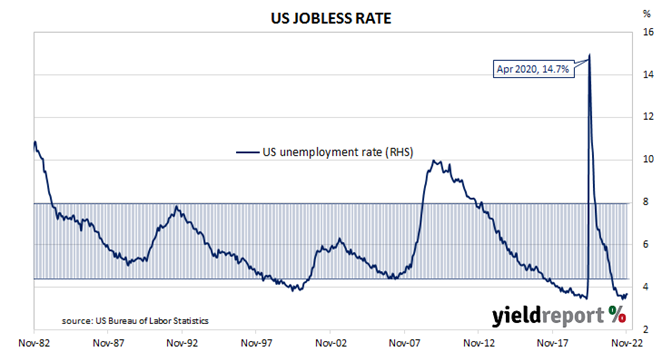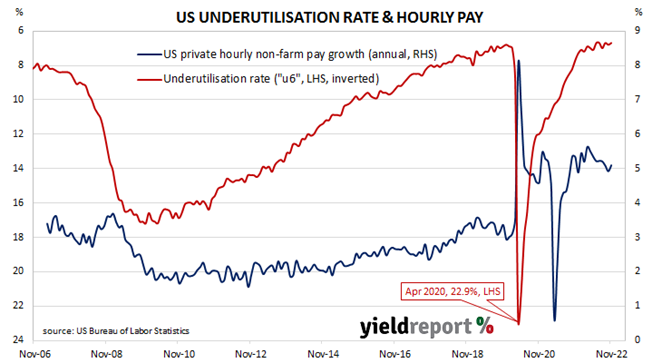Summary: Non-farm payrolls up 263,000 in November, greater than expected; previous two months’ figures revised down by 23,000; jobless rate steady at 3.7%, participation rate slips to 62.1%; US jobs market “showing a lot of resilience”; jobs-to-population ratio slips to 59.9%; underutilisation rate down from 6.8% to 6.7%; annual hourly pay growth up from 4.9% to 5.1%.
The US economy ceased producing jobs in net terms as infection controls began to be implemented in March 2020. The unemployment rate had been around 3.5% but that changed as job losses began to surge through March and April of 2020. The May 2020 non-farm employment report represented a turning point and subsequent months provided substantial employment gains. Changes in recent months have been generally more modest but still above the average of the last decade.
According to the US Bureau of Labor Statistics, the US economy created an additional 263,000 jobs in the non-farm sector in November. The increase was greater than the 200,000 which had been generally expected but slightly less than the 284,000 jobs which had been added in October after revisions. Employment figures for September and October were revised down by a total of 23,000.
The total number of unemployed declined by 48,000 to 6.011 million while the total number of people who were either employed or looking for work decreased by 186,000 to 164.481 million. These changes led to the US unemployment rate remaining at 3.7% as the participation rate slipped from October’s rate of 62.2% to 62.1%.
“The labour market is showing a lot of resilience in the face of aggressive Fed tightening,” said ANZ Head of Australian Economics David Plank. “Labour force participation remains moribund amid the ongoing early retirement trend, suggesting wage growth will remain elevated.”
Short-term US Treasury yields rose noticeably on the day while long-term yields fell back. By the close of business, the 2-year yield had gained 7bps to 4.29%, the 10-year yield had lost 2bps to 3.49% while the 30-year yield finished 5bps lower at 3.55%.
In terms of US Fed policy, expectations of higher federal funds rates over the next 12 months firmed. At the close of business, contracts implied the effective federal funds rate would average 4.12% in December, 29bps higher than the current spot rate, and then climb to an average of 4.695% in February 2023. May 2023 futures contracts implied a 4.815% average effective federal funds rate while November 2023 contracts implied 4.62%.
One figure which is indicative of the “spare capacity” of the US employment market is the employment-to-population ratio. This ratio is simply the number of people in work divided by the total US population. It hit a cyclical-low of 58.2 in October 2010 before slowly recovering to just above 61% in late-2019. November’s reading slipped from 60.0% to 59.9%, some way from the April 2000 peak reading of 64.7%.
Apart from the unemployment rate, another measure of tightness in the labour market is the underutilisation rate and the latest reading of it registered 6.7%, down from 6.8% in October. Wage inflation and the underutilisation rate usually have an inverse relationship; hourly pay growth in the year to November increased from 4.9% after revisions to 5.1%.



